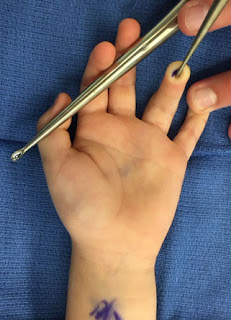I have blogged several times on camptodactyly as it is a common finger anomaly and I have received regular requests for information on the topic. Those posts can be found HERE and HERE and HERE and HERE. The popularity of the topic camptodactyly can be seen with the large number of comments and questions on the last link.
The medical literature tends to assess outcomes and causes of camptodactyly– neither of which is easy to do. There are many reported causes including unusual tendons, tight tendons and an imbalance between tendons that bend (too strong) and straighten the finger. There is also much information about associated conditions and syndromes (arthrogryposis, for example). A Google search on camptodactyly returns 86, 500 results with many of the first page results from hospitals, Wikipedia, and other information sites.
My general philosophy in treating camptodactyly is therapy first which includes splinting and stretching. Most kids will respond to therapy and, even if not perfect, the finger becomes fully functional and surgery is avoided. Some kids, unfortunately either fail therapy (therapy is attempted but not successful) or can never really try it because the deformity is too severe to allow effective splinting. Those kids may benefit from surgery although families should know that surgery is unlikely to provide a fully mobile finger.
I wanted to share early outcomes of one child with camptodactyly. He had an isolated ring finger flexion deformity without associated syndrome or other anomalies.
 |
| Camptodactyly, bent finger deformity, resting posture. |
 |
| Camptodactyly, bent finger deformity, resting posture. |
 |
| Camptodactyly, bent finger deformity, resting posture. Attempted extension demonstrates a nearly 90 degree contracture. |
This child was sent to therapy but ultimately, the degree of deformity contributed to a failure of splinting and stretching. Surgical release of the tight structures in this camptodactyly was performed with straightening of the finger. In addition, once such fingers are released, there is often a skin deficit. We have been using a rotation flap to cover this deficit and avoid bigger flaps or skin grafts.
 |
| Camptodactyly 1 week after surgery. The pin is still in place (removed that day). Note the triangular flap which was rotated to cover the deficit. |
 |
| Camptodactyly 5 weeks after surgery. Note how the patient can straighten the finger and the flap is healed nicely. |
 |
| Camptodactyly 5 weeks after surgery. Flexion of the finger continues to improve. |
This patient is doing well and both bending and straightening the finger should improve with time and therapy. The lack of full flexion (bending) as demonstrated above does demonstrate a key point in the treatment of kids with camptodactyly– we need to be careful to avoid loosing finger flexion and work on flexion and extension (straightening) after surgery.
My Bio at Washington University
congenitalhand@wudosis.wustl.edu
I am 26 years old and my small finger on right hand is 90 degree.Is it anything I can do or is very late for surgery?My other fingers also don't fully open but they are in a better situation.My small finger makes it difficult my hand function.
Ramshire,
Thank you for the question. A 90- degree bend is significant and patients often note that the finger 'gets in the way'. It can also make shaking hands a challenge. Sometimes surgery can be helpful although there are many factors to consider including the joint (whether or not there is arthritis). A hand surgeon (ideally one that has experience with birth differences like camptodactyly) could likely help.